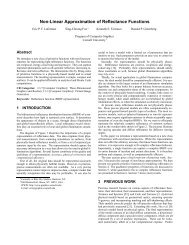pigmented colorants: dependence on media and time - Cornell ...
pigmented colorants: dependence on media and time - Cornell ...
pigmented colorants: dependence on media and time - Cornell ...
Create successful ePaper yourself
Turn your PDF publications into a flip-book with our unique Google optimized e-Paper software.
the iris. When this b<strong>and</strong> of muscles c<strong>on</strong>tracts, the pupil gets smaller. The sec<strong>on</strong>d<br />
set of muscles run radially from the edge of the first set of muscles. When this<br />
set c<strong>on</strong>tracts, the eye dilates <strong>and</strong> the gap widens. These muscles determine the<br />
amount of light that reaches the back of the eye.<br />
The size of the pupil is dependent <strong>on</strong> the availability of light in the surroundings.<br />
The size of the pupil is inversely proporti<strong>on</strong>al to the amount of available light.<br />
Hence, your pupil opens more in low-light situati<strong>on</strong>s. In young adults, the pupil’s<br />
diameter varies over a range of 4:1, which fluctuates the amount of light from 16:1<br />
[SB02]. To underst<strong>and</strong> why large pupils are not always used, we <strong>on</strong>ce again turn<br />
to photography. The aperture, or opening, of a camera restricts the diameter of<br />
the c<strong>on</strong>e of light which reaches the film. A device called the diaphragm c<strong>on</strong>trols<br />
the opening <strong>and</strong> can be modified in a similar manner to the iris. Reducing the<br />
aperture size increases the depth of field, or the range of objects in focus in an<br />
image. While sharp images are desirable, they require small apertures, resulting<br />
in the need for much more light.<br />
A very important optical element in the eye is the crystalline lens, which resides<br />
right behind the iris. The covering of the lens is an elastic capsule, which varies the<br />
optical power of the lens by molding the shape. By shifting <strong>on</strong>e’s focus between<br />
near <strong>and</strong> far objects, you are c<strong>on</strong>sciously adjusting the shape of the lens. This fine<br />
tuning of the focus of image <strong>on</strong> the back of the eye is know as accommodati<strong>on</strong>.<br />
A c<strong>on</strong>diti<strong>on</strong> of the hardening of the fibers in the lens is called sclerosis, which di-<br />
minishes <strong>on</strong>e’s ability to accommodate objects of varying distances. Similar to the<br />
cornea, the lens is also susceptible to transparency issues. Reduced transparency<br />
in the lens is called a cataract.<br />
The innermost of the eye’s three layers, the retina, is where light from the<br />
59



